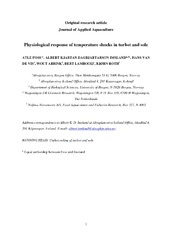| dc.contributor.author | Foss, Atle | |
| dc.contributor.author | Imsland, Albert | |
| dc.contributor.author | van de Vis, Hans | |
| dc.contributor.author | Abbink, Wout | |
| dc.contributor.author | Lambooij, Bert | |
| dc.contributor.author | Roth, Bjørn | |
| dc.date.accessioned | 2020-05-12T11:08:39Z | |
| dc.date.available | 2020-05-12T11:08:39Z | |
| dc.date.issued | 2019 | |
| dc.Published | Foss A, Imsland A, van de Vis H, Abbink W, Lambooij B, Roth B. Physiological response of temperature shocks in turbot and sole. Journal of Applied Aquaculture. 2019;31(1):34-47 | eng |
| dc.identifier.issn | 1545-0805 | en_US |
| dc.identifier.issn | 1045-4438 | en_US |
| dc.identifier.uri | http://hdl.handle.net/1956/22197 | |
| dc.description.abstract | In the present study, selected temperature drops were examined to investigate the effects of live chilling on stress and welfare in turbot and sole. This study demonstrated that rapid temperature drops from 11°C–12°C and 18°C–18.7°C to 4°C–0°C in turbot resulted in higher blood sodium and potassium at 0°C (164 mmol l−1, 4.4 mmol −1) compared to 4°C (153 mmol l−1, 3.1 mmol −1), indicating osmoregulatory disturbance. A rapid temperature drop from 18°C to 0°C in Senegal sole also resulted in higher blood sodium and potassium at 0°C (164 mmol l−1, 4.8 mmol −1) compared to the control group at 18°C (157 mmol l−1, 3.2 mmol −1). Based on present findings, we conclude that immersion in ice water will have a negative effect on the animal osmoregulatory capacity, and we recommend that turbot and sole are stunned before slaughter. | en_US |
| dc.language.iso | eng | eng |
| dc.publisher | Taylor & Francis | en_US |
| dc.title | Physiological response of temperature shocks in turbot and sole | en_US |
| dc.type | Peer reviewed | |
| dc.type | Journal article | |
| dc.date.updated | 2020-01-21T17:29:50Z | |
| dc.description.version | acceptedVersion | en_US |
| dc.rights.holder | Copyright 2018 Taylor & Francis | en_US |
| dc.identifier.doi | https://doi.org/10.1080/10454438.2018.1548404 | |
| dc.identifier.cristin | 1681163 | |
| dc.source.journal | Journal of Applied Aquaculture | |
